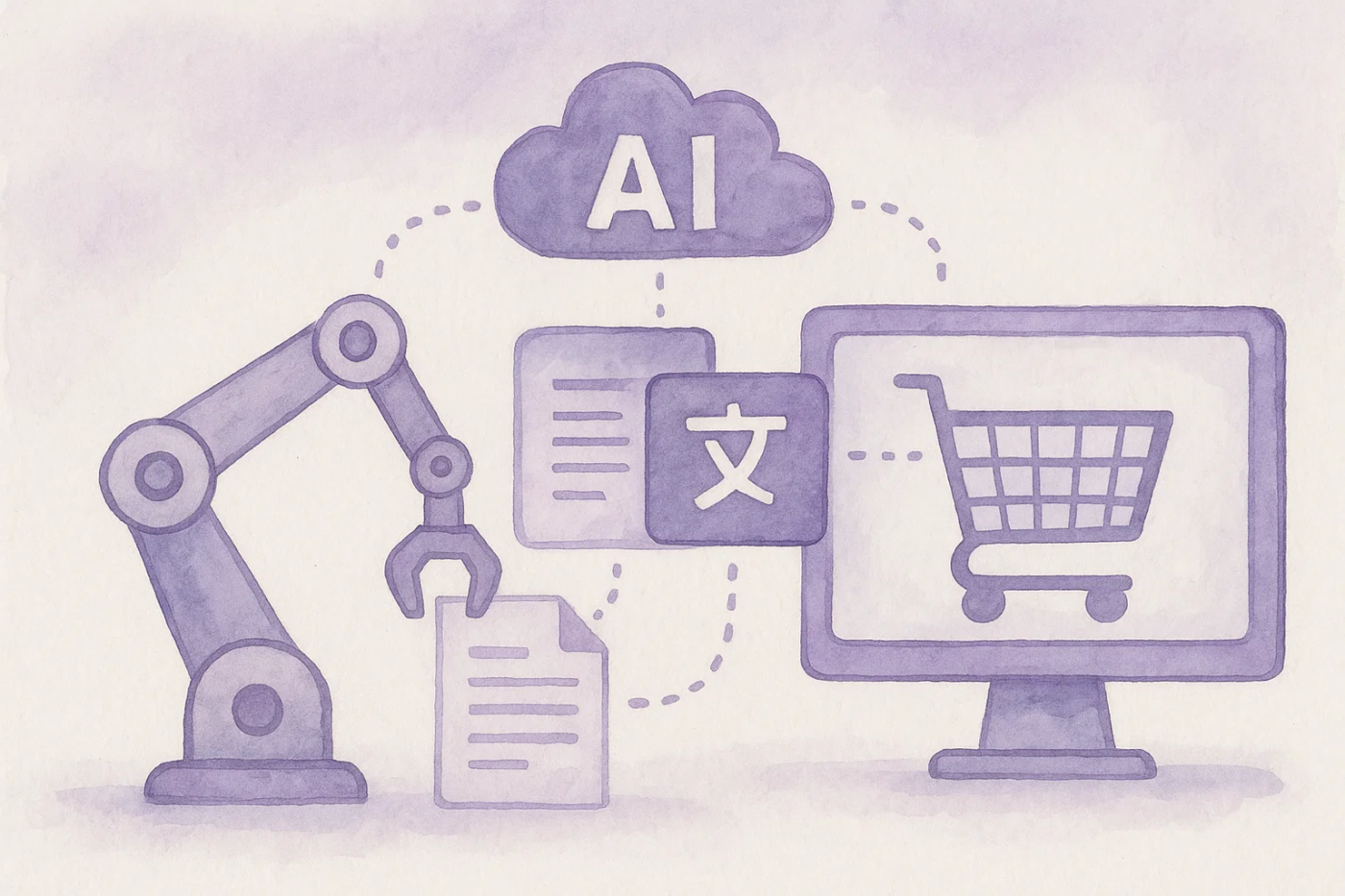Automation & AI Translation: The New Backbone of E-Commerce Content

AI automations are everywhere, but many people forget to add it to one more area, and that’s AI translation. This is a huge opportunity that too many people miss on just because they don’t invest the time and money to do this right.
Global e-commerce is no longer a trend, it’s the default.
Borders have blurred, and brands are now expected to serve diverse audiences with tailored, consistent content across markets.
But here’s the catch: scaling high-quality, localized content at speed is nearly impossible with manual processes alone.
But today we have automation and AI translation, the twin engines powering the next generation of e-commerce content.
These technologies are reshaping how online retailers create, manage, and distribute digital assets across languages, regions, and platforms. By combining speed with sophistication, they’re redefining what’s possible in global commerce.
Today we will explore how automation and AI translation are not just tools, but strategic necessities.
We’ll break down what they do, how they work, and why they’ve become the new backbone of e-commerce content for businesses aiming to grow, and win, on a global scale.
Automation in E-Commerce Content
Let’s be honest, in an ideal world everything would be done by a professional but when you have an E-Commerce store with 50,000 SKUs and you add more daily… It becomes unreasonable to expect your team to keep up without automation tools.
Content Creation at Scale
Creating content used to be a bottleneck.
Now, it’s a launchpad. Natural Language Processing (NLP) and Natural Language Generation (NLG) tools can automatically craft everything from product descriptions and blog posts to social captions and email campaigns.
The result? Faster content production, consistent brand voice, and fewer hours spent drafting from scratch.
Workflow Automation
Behind every piece of published content is a series of steps, drafting, reviewing, approving, publishing.
Automation tools streamline these workflows, enabling content teams to work smarter, not harder.
By reducing manual handoffs and eliminating repetitive tasks, businesses gain time to focus on strategy, creativity, and innovation.
Personalization
In a digital marketplace flooded with choice, relevance is king.
Machine learning algorithms analyze user behavior, clicks, searches, purchases, to tailor content and product recommendations.
Campaign segmentation is automated, allowing for targeted messaging at scale, increasing engagement and boosting conversions.
Consistency + Cost Savings
Content automation ensures that product listings, images, and descriptions remain consistent across all platforms, marketplaces, and regions.
Automated quality checks and taxonomy management reduce human error.
The added bonus? Massive cost savings. With fewer manual tasks, teams can reallocate resources where they matter most, into growth and expansion.
AI Translation, The Key to Going Global
Language is no longer a barrier, it’s a bridge. And AI translation is building it faster than ever.
Breaking Language Barriers
Today’s AI-powered translation tools don’t just swap words, they decode meaning. By leveraging neural machine translation and advanced deep learning plus large language models, these systems can rapidly localize thousands of SKUs, product descriptions, and customer communications.
The days of clunky, literal translations are over; now, e-commerce brands can speak to international audiences in fluent, polished, and accurate language, within seconds.
Context-Aware + Culturally Relevant
Good translation goes beyond grammar. AI systems are now context-aware, understanding industry terminology, brand tone, and cultural nuance.
That means your edgy fashion copy, your beauty blog’s tone, or your brand’s eco-conscious ethos stays intact across German, Japanese, Spanish, or Portuguese, without sounding like a Google Translate experiment.
In short: it’s not just localization, it’s cultural fluency at scale.
Customer Experience
Imagine shopping online and finding everything, product details, reviews, support chat, presented seamlessly in your native language.
That’s the competitive edge.
With multilingual UX, automated chatbot translation, and localized content, customers feel seen, understood, and valued.
And research backs it: consumers are significantly more likely to complete purchases on sites presented in their own language. Translation isn’t a courtesy, it’s a conversion tool.
Scalability and Savings
AI translation can localize content at a rate, and cost, that manual efforts simply can’t match.
Brands have reported up to 70% cost reductions by replacing traditional workflows with AI-powered translation pipelines.
Thousands of product pages? No problem. Seasonal campaigns across six continents? Bring it on.
AI translation delivers global reach without proportionate scaling of headcount or budget.
Automation + AI Translation = Global Content Engine
Individually, automation and AI translation are powerful. Combined, they’re unstoppable.
Real-World Impact
Case studies speak volumes.
A major fashion retailer that embraced content automation and AI translation saw international sales spike 45% while slashing time-to-market by weeks.
Marketing teams now launch multilingual campaigns simultaneously, rather than in fragmented phases.
What once took months is now done in days, sometimes hours.
Content Ecosystem
The synergy goes beyond efficiency.
Automation ensures content flows smoothly from ideation to publication.
AI translation ensures that same content resonates globally.
Together, they create a cohesive, scalable content ecosystem that preserves SEO integrity, brand tone, and strategic messaging across markets and languages. Everything syncs, without duplication of effort.
Future-Proof Strategy
The digital marketplace isn’t slowing down, it’s accelerating.
Brands that invest in automation and AI translation aren’t just keeping up, they’re building for longevity.
These technologies are no longer optional; they are infrastructure.
The foundation of every global brand’s content stack.
Adopt them now, and you’re not just adapting, you’re leading.
Conclusion: Why This Matters Now
In today’s fast-evolving digital marketplace, automation handles the how, streamlining and scaling content creation like never before.
Meanwhile, AI translation solves the where, breaking down language barriers to unlock new global markets.
Together, they form the infrastructure of scalable, personalized, global-ready content, the backbone every e-commerce brand needs to compete internationally without sacrificing speed, quality, or relevance.
Brands that embrace this powerful duo today aren’t just optimizing operations, they’re positioning themselves as leaders in the next wave of global e-commerce success.
The future is automated, localized, and brilliantly connected. The question is: will you be ready?
FAQs about AI Translation & Automation
1. How does AI translation differ from traditional translation services?
AI translation uses neural networks and deep learning to rapidly generate context-aware, culturally relevant translations at scale, unlike manual methods which are slower, costly, and often less consistent.
2. Can automated content creation match human quality?
Modern NLP and NLG tools can produce high-quality, brand-consistent content for many use cases. However, human oversight remains important for nuanced, creative, or highly specialized content.
3. Is it safe to fully automate product descriptions and customer-facing content?
With proper setup, automated content can maintain accuracy and brand voice. Automated quality checks and periodic human reviews ensure the content remains reliable and engaging.
4. What kind of ROI can e-commerce businesses expect from implementing these technologies?
Businesses report up to 70% cost reductions in translation, faster time-to-market, and significant boosts in international sales, some seeing increases of 40% or more.
5. How do automation and AI translation impact SEO and localization efforts?
These technologies help maintain SEO integrity by ensuring keyword optimization, consistent metadata, and localized content that resonates with regional search behaviors, enhancing organic reach across markets.





